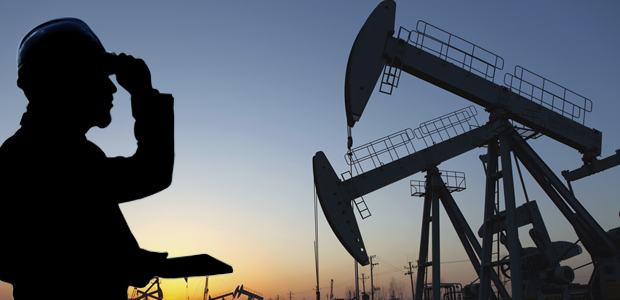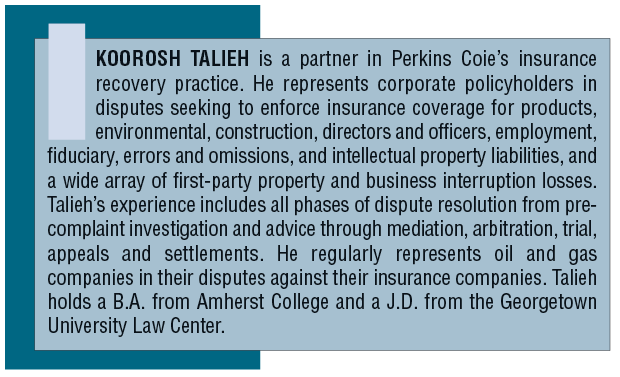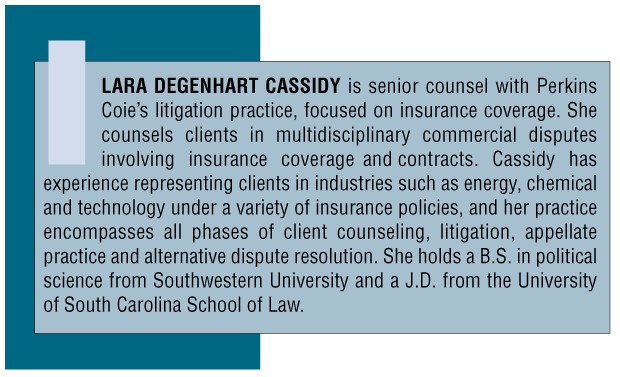
Frac Insurance
Policies Protect Against Fracturing Claims
By Koorosh Talieh, Lorelie “Lorie” S. Masters and Lara Degenhart Cassidy
WASHINGTON–The new wave of civil and regulatory litigation against and among entities involved in hydraulic fracturing has raised questions about how insurance can respond to frac-related liabilities. Prospective coverage disputes between fracturing entities and their insurers should not strike fear into the hearts of energy companies or their risk managers, however. Simply put, there’s insurance coverage for that!
At latest count, some 50 fracturing-related lawsuits were pending in courts across the United States against well operators and contractors; manufacturers of well equipment; landowners (including municipalities) where fracturing activities take place; and companies involved in storing, treating, transporting and disposing of frac products and waste.
The most common type of litigation alleges bodily injury or property damage arising from contaminated groundwater (methane or components of frac fluids, other byproducts, and waste). In these cases, individuals, municipalities and public-interest groups argue that fracturing operations near or beneath specific property have led to diminished property values, ruined water wells, or caused sickness and even death.
Other types of claims include claims for damages from alleged air pollution, nuisance and trespass, well blowouts, earthquakes, and even corporate malfeasance by directors and officers of companies involved in hydraulic fracturing. Frac crew workers may claim injury from exposure to chemicals, gasses and silica dislodged in the well stimulation process.
Companies facing fracturing liabilities often turn to their contractors, including entities with which they have entered into indemnity or hold-harmless agreements. Regulatory agencies have charged fracturing entities with violating certain state and federal environmental statutes, and spearheaded investigations into corporate disclosures about the risks and rewards of their operations. Shareholders, too, are questioning the propriety of corporate disclosures that allegedly affect company stock prices.
Coverage Disputes
As frac-related litigation proliferates, so does the need for companies to tap into their insurance coverage to pay the costs of defending and resolving the litigation. Obtaining coverage can appear daunting, as insurers throw up roadblocks from the outset of the process, and add new hurdles each time a policyholder makes it over the previous one. For better or worse, however, the insurers’ response to fracturing litigation is akin to how they approach virtually any large-scale litigation, and does not necessarily reflect any “singling out” of frac-related claims.
Here, as elsewhere, insurers argue by rote that the litigation seeks damages not covered under the policy; that various policy exclusions apply; and that the entity incurring the damages is not an “insured” under the policy.
However, one significant point distinguishes frac insurance claims from other energy-related claims: the magnitude and complexity of even “small” fracturing operations. The same geographic area that once supported a single well under traditional drilling methods now can have up to 60 wells. The multiwell pad may be located near or even inside of cities, by neighborhoods, parks, schools, and in some cases, public water sources.
Each location may have multiple drillers, producers, transporters and other well servicers operating simultaneously, with different levels of expertise and different risk-tolerance levels. Each entity may have its own insurance program with varying coverage limits, deductibles, or self-insurance retentions, potentially inconsistent grants of coverage and exclusions, and competing rules requiring the entity to pursue other sources of insurance first.
The entities may have entered into contracts with cross-indemnification and hold-harmless agreements, requirements that they add one another as additional insureds, and detailed descriptions of the responsibility that each company exerts over frac operations. Given this tangled web, a single release of frac fluids–much less an extensive well blowout–could ripple through multiple wells, companies, individuals, agreements and insurance policies, much like a rush-hour freeway pileup in “pea soup” fog.
In light of these complexities, insurance companies have turned their collective eye on the fracturing industry. As a general business model, insurers profit when they receive more in premiums than they pay out in claims and claims-handling expenses. Multiparty fracturing litigation threatens this business model, because an insurer may have to invest significant time and resources to assess its coverage obligations within the fracturing web, and then may have to cover substantial liabilities of its policyholder.
To protect their bottom lines, insurers are taking a hard look at all fracturing claims that cross their desks. They are incorporating frac-related exclusions into their policies, and are encouraging the companies they insure to follow operating practices designed to minimize future risks.
For example, insurance underwriters may require policyholders to provide information during the policy application or as part of the renewal process that commits the policyholder to use state-of-the-art methods regarding well casing integrity; to vet its subcontractors in terms of experience and safety records; and to implement formal corporate guidelines covering safety and public disclosures about the risks and rewards of fracturing.
Policies Providing Coverage
Heightened public and private attention to hydraulic fracturing, not the least of which is by the insurance industry, compels policyholders to review their insurance policies before claims are asserted against them. This policy review can give the policyholder comfort that its existing policies are structured to address the company’s actual frac-related risks. The policies that an energy company likely already has in hand, and which may be implicated by frac claims, include:
- Comprehensive general liability (CGL);
- Environmental impairment liability (EIL);
- First-party property (property);
- Operator’s extra expense (OEE); and
- Directors and officers (D&O) policies.
CGL policies are the single most important coverage that a business involved in fracturing should have in its insurance program. These policies broadly protect companies from liability for bodily injury, property damage, and potentially, nuisance and trespass. Indeed, CGL policies have historically provided substantial coverage to policyholders for claims alleging bodily injury or property damage arising from the policyholder’s operations, including asbestos, well water degradation, and drilling explosion claims.
Furthermore, CGL coverage typically extends to subcontractors or other entities for which the policyholder has contractually agreed to procure insurance, or with which the policyholder has a contractual indemnity or hold-harmless agreement.
Most significantly, CGL policies promise to pay for the costs the policyholder incurs while defending against a lawsuit. That defense coverage is an important asset, as it may not be subject to limits, and the costs of defense may exceed potential liability (if any). In fact, this defense coverage is so important that CGL insurance is also referred to as “litigation insurance.” Courts uniformly recognize that the insurer must defend the policyholder when a potentially covered claim arises, even while the insurer is sorting out the extent to which it is obligated to provide coverage.
EIL policies provide coverage for bodily injury and property damage, as well as government-mandated investigation and cleanup costs arising out of pollution claims. EIL insurance is claims-made coverage, meaning that the policy in effect when the claim is first made against the company is the one that must respond. The policy may also require the company to give notice of the claim to the insurer during the policy period, or shortly after it ends.
Property insurance policies cover not only physical damage or loss to the policyholder’s own property, but also cover the policyholder’s loss of income from interruption of its business. An issue associated with fracturing activities may halt the policyholder’s business operations, creating loss of business income. Business interruption (BI) insurance also may cover losses of income from government orders or interruption to a supplier’s business. BI coverage may prove invaluable when a policyholder loses profits due to an interruption in its operations.
Operating companies often purchase OEE policies, which provide protection against losses arising from well blowouts (a named peril). CGL and EIL policies typically exclude such coverage. OEE policies cover expenses incurred for controlling an out-of-control well, redrilling and restoring the well, and liability for any above-ground pollution.
D&O insurance protects a company and its senior management against claims by shareholders and certain other third parties that allege corporate negligence or other malfeasance. Fracturing activities could lead to claims alleging that management failed to exercise due care to prevent underlying frac-related liabilities. D&O insurance also protects against securities litigation and costs of investigations by regulatory agencies questioning whether frac activities violated environmental laws, or were properly accounted for and reflected in public disclosure statements. D&O insurance covers both defense and indemnity costs.
In some situations, a policy review may turn up gaps and shortcomings in coverage. For example, the review may identify policy exclusions that could wipe out coverage for fracturing claims, or suggest that higher policy limits would better protect valuable drilling and completion equipment. Armed with this information, the policyholder may choose to enhance its existing insurance, or to purchase supplementary policies to fill the gaps, such as OEE policies.
Finally, the review may invigorate the policyholder to reconsider its agreements with other contractors to protect against the likelihood that the policyholder or its insurers will incur costs for another entity’s wrongdoing as the result of unclear liability-shifting provisions.
Pursuing Full Coverage Benefits
Once a fracturing-related claim arises, policyholders should promptly look to their insurers to protect them against the significant defense costs the claim may generate, as well as any damages paid in that action. As noted, CGL and D&O policies, in particular, are designed to protect companies from the full costs of defending claims.
Giving prompt notice is important, even if the company questions whether its policies apply to the claim. Policyholders cannot get insurance coverage if they do not give an insurer notice.
Once the policyholder gives notice, it should prepare for the insurer to throw out its inevitable laundry list of coverage defenses in response. As discussed above, an insurer’s business model depends on keeping costs low. Therefore, insurers hire professional staff and sometimes outside insurance counsel to scrutinize and either deny or shrink the claims for which their policyholders seek coverage. An insurer seeking to avoid a claim may have a valid basis to narrow its obligation in some circumstances. But all too often, the insurer hides behind buzzwords and bluster to curtail its coverage duties.
A policyholder should not simply accept its insurer’s conclusion that a particular coverage defense applies. By way of illustration, insurers routinely argue that the so-called “pollution exclusion” in a CGL policy bars coverage because the chemicals present in frac fluid, such as methanol and boric acid, allegedly are pollutants. For the fracturing entity that uses those chemicals in its day-to-day operations, however, they are not pollutants, they are business tools. And the insurer that has agreed to stand behind the entity’s business operations should not be allowed to say otherwise after a claim arises. That’s impermissible “post-claim underwriting” in insurance speak, and it renders the policy illusory.
Any company facing a catastrophic fracturing claim justly wants to focus its energy and resources on resolving that claim, not on wrestling with insurers. When frac-related litigation arises, it may want to consider having outside insurance advocates, such as insurance brokers and specialized insurance counsel, work with the company’s risk manager to develop and implement a comprehensive strategy for maximizing insurance coverage. Having outsiders pursue coverage may be particularly helpful if a policyholder is concerned about its in-house team maintaining a good working relationship with the insurer, for example, because it is in the process of seeking a policy renewal.
Fracturing-related litigation and liability are extraordinary situations, no matter how they arise. As such, they are precisely the kind of risks for which oil and gas companies purchase and maintain insurance. Insurance companies would prefer to stave off frac-related claims because they are potentially complicated, expensive and numerous. But despite the insurers’ best efforts, the point remains that, yes, there is insurance coverage for that.
For other great articles about exploration, drilling, completions and production, subscribe to The American Oil & Gas Reporter and bookmark www.aogr.com.
















